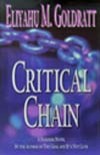|
|
|
|
|
|
Critical Chain Project Management (UMTPM017)
|
|
|
Overview
This course on the critical chain scheduling technique is designed to introduce students to a new approach to scheduling that is leading to the creation of more realistic schedules than we have experienced using traditional scheduling techniques. One theme that will be emphasized is that critical chain scheduling is practical. Many people, when they understand the basic notions of critical chain scheduling, make the comment: "Why, it's just common sense scheduling!" They are correct.
When studying the critical chain method, it is important that students do not approach it as some arcane methodology that requires advanced knowledge of mathematics and operations research. While all scheduling requires discipline, estimating skills, and the ability to handle numbers, it is not rocket science. If you find yourself getting hung up on technique and you ignore common sense and good judgment, then you are doing something wrong. The most advanced scheduling algorithm in the world has little value if it does not accommodate human foibles, inconsistencies, politics, resource bottlenecks, and other "soft" issues of this ilk.
This course takes a common sense approach. Once students have completed it, they can start applying the principles they have learned. For those of you who want to explore the material in more detail, you should certainly read Robert C. Newbold's book, Project Management in the Fast Lane (Saint Lucie Press, 1999), and, of course, should obtain a copy of Eliyahu Goldratt's seminal work (a novel) titled Critical Chain (The North River Press, 1997).
Note: Students who take Critical Chain Project Management should not take UMTPM251. Planning and Control.
|
Objectives
- To demonstrate that the chief constraints affecting project schedules are bottlenecks
- To show how bottlenecks can be identified
- To highlight important problems of estimating durations -- the Student Syndrome and Parkinson's Law
- To demonstrate the most effective way of estimating task durations
- To show the best ways to compute project buffers, feeder buffers, and resource buffers.
/ul>
|
What You Will Learn
- Why schedules slip, even when they are heavily padded with extra time
- How to add padding to a schedule in such a way as to reduce project length dramatically
- How to improve schedule performance by identifying and fixing bottlenecks
|
PMBOK® Guide Process Areas
- Initiating
- Planning
- Monitoring and Controlling
|
PMBOK® Guide Knowledge Areas
- Project Integration Management
- Project Time Management
- Project Scope Management
- Project Cost Management
|
|
Instruction
  - Course modules containing cutting-edge knowledge developed by renowned experts in project management
- Course supplemental reading: The Critical Chain, a book by Eliyahu Goldratt
- Mentors Studio™ CD-ROM: Critical Chain Scheduling, featuring Dr. J. Davidson Frame
- "Think and Review" section that helps you review key points of the modules
- Answers to the "Think and Review" section
- A final exam which contains multiple choice and true/false questions
- Certificate of Completion.
|
|
|
|
|
|
|
|
|
|
|
|
|
|
Privacy Policy
| Contact Us |
Copyright © 1998-2025 University of Management and Technology (UMT) |
Consumer Information Disclosure
|











